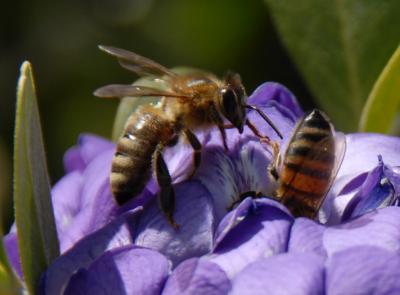A new paper has found that two broad-spectrum systemic insecticides, fipornil and imidacloprid, may be impacting honeybees.
Fipronil, part of the phenylpyrazole chemical family, is a highly effective insecticide which can be applied at very low doses for everything from crop to veterinary pests. Imidacloprid is in the class of chemicals called neonicotinoids - it mimics nicotine, which can be toxic to sucking insects like fleas and termites but has no effect on mammals.
Recently, there has been concern about colony collapse disorder (CCD) in honeybees - this also happened decades ago and is the reason neonicotinoids, which are much less dangerous in the environment, came into popular use. Studies have absolved neonics and the colony problem has largely been limited to one region, because almost every region has neonics, but the new paper finds that fipornil and imidacloprid are inhibitors of mitochondrial bioenergetics, resulting in depleted cell energy. The authors say this might impact honeybees in ways other studies would not show.

Credit: Jacob Sahertian, Arizone State University
Honeybees are, of course, vital. These colony collapses have been documented regularly since humans started keeping records of honeybees but it merits investigation because the cross-pollination services they provide are required by approximately 80 percent of all flowering plants, and one-third of all agricultural food production directly depends on bee pollination.
The recent collapse has been attributed to parasitic mite infestations, viral diseases, and less convincingly to indirect impacts of pesticides, since the effects of pyrazoles (fipronil) and neonicotinoids (imidacloprid) on the nervous system are fairly well documented.
In this study, Daniel Nicodemo, professor of ecology and beekeeping at the Universidade Estadual Paulista in Dracena, Brazil, and colleagues looked at the effects of fipronil and imidacloprid on the bioenergetics functioning of mitochondria isolated from the heads and thoraces of
Africanized honeybees. Mitochondria are the power plants of a cell, generating most of a cell's supply of adenosine triphosphate (ATP), used as a source of chemical energy.
Honeybee flight muscles are strongly dependent on high levels of oxygen consumption and energy metabolism. Mitochondrial oxidative phosphorylation drives ATP synthesis, which is required to contract the muscles during flight.
"If something goes wrong, the energy production is impaired," explains Nicodemo. "Similar to a plane, honeybees require clean fuel in order to fly." Both fipronil and imidacloprid negatively affected the mitochondrial bioenergetics of the head and thorax of the honeybees. While at sublethal levels, insecticide damage may not be evident, even such low level exposure clearly contributes to the inability of a honeybee to forage and return to the hive, which could result in declining bee populations.






Comments